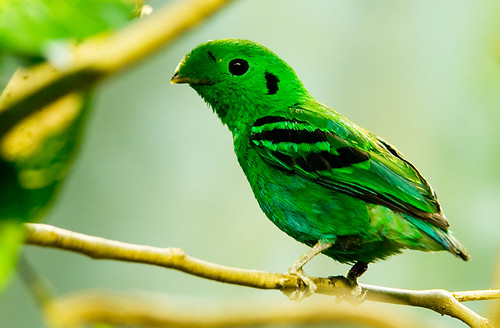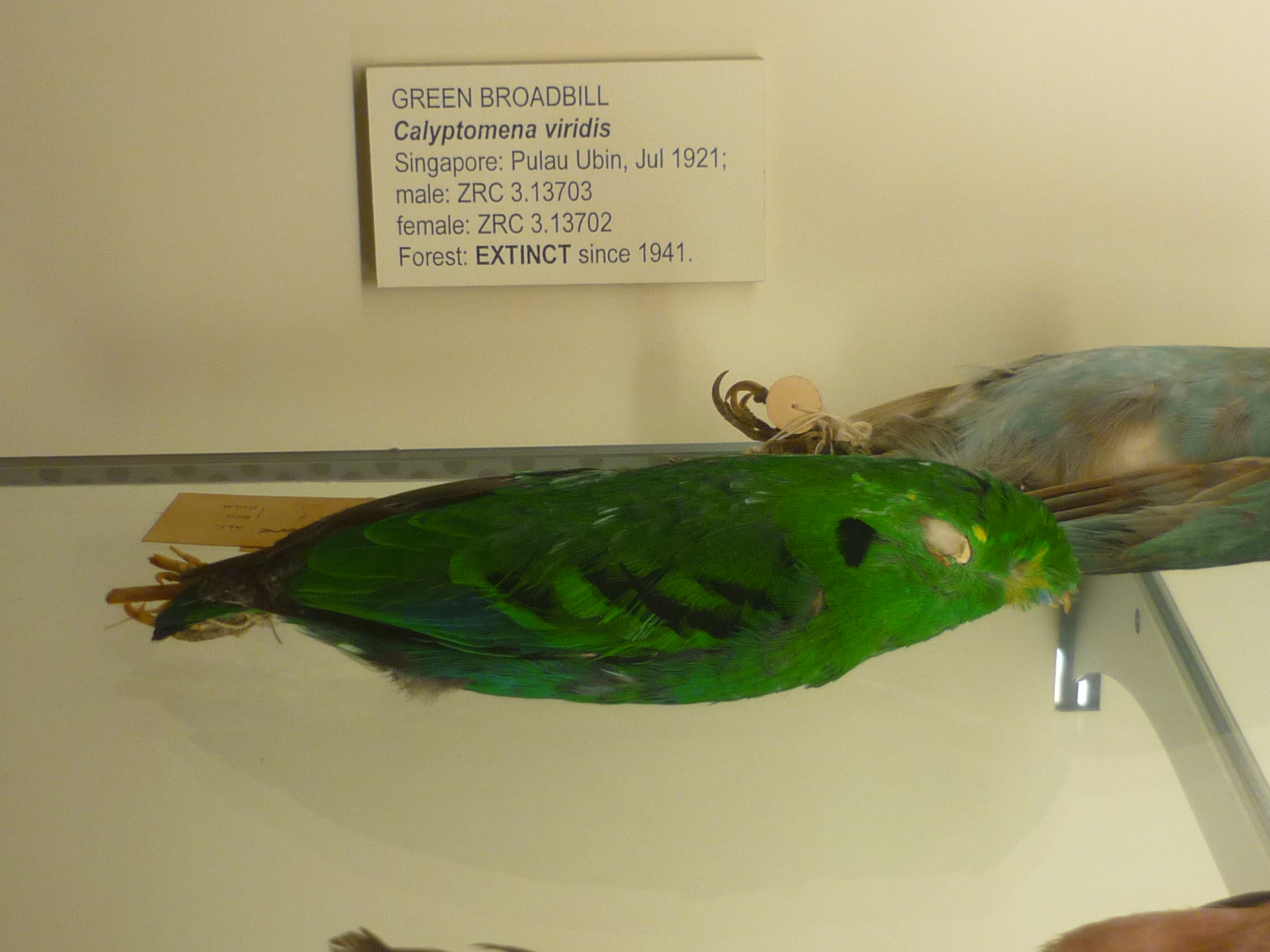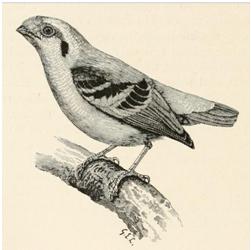Calyptomena viridis Raffles, 1822 (Asian Green Broadbill / Green Broadbill / Lesser Green Broadbill)

(Photo taken by: Ken Ilio at the birdhouse of the Lincoln Park Zoo, Chicago, United States of America)
BUT...

EXTINCT in Singapore!!!
IMPORTANT: Conservation
Status: Near Threatened (NT)
Year Assessed: 2008
Assessor: BirdLife International
Reviewers: Butchart, S. & Gilroy, J. (BirdLife International Red List Authority)
Justification: Although this species remains common in many parts of its large range, it is considered Near Threatened as it is highly sensitive to habitat loss and degradation, which are likely to have caused moderately rapid population declines throughout its range.
History:
2004 (Near Threatened)
2000 (Lower Risk/near threatened)
1994 (Lower Risk/least concern)
1988 (Lower Risk/least concern)
Threats: Rates of forest loss in the Sundaic lowlands have been extremely rapid, owing partly to the escalation of illegal logging and land conversion, with deliberate targeting of all remaining stands of valuable timber including those inside protected areas. Forest fires have also had a damaging effect (particularly in 1997-1998).
Population trend is decreasing.
No targeted conservation actions are known for this species.
Conservation measures proposed: Conduct repeated surveys across the range to determine the magnitude of declines and rates of range contraction. Conduct ecological studies to improve understanding of its precise habitat requirements, tolerance of secondary habitats and response to fragmentation. Campaign for the protection of remaining tracts of lowland forest throughout the range.
Biology
Feeding Habits
It feeds largely on soft figs and helps to distribute the seeds of the fig around the forest floor. Hence, it serves an important ecological function.
Reproduction
The female usually lays between 2-3 whitish eggs, and the young fledge after 22-23 days.
Distribution
Terrestrial. Occurs primarily in the understorey of primary evergreen and mixed dipterocarp forest in the lowlands, principally below 800 m, but occasionally to 1,700 m. It is also found in tall secondary forest and other secondary habitats if primary forest is adjacent.
(Map taken from: IUCN)
Diagnosis
This species can be identified by its vibrant green plumage. Males are more distinct as they have a black spot behind the eye and three black bands across the wing.
(Drawing taken from: The Cambridge natural history / edited by S. F. Harmer and A. E. Shipley)
Description
General
Small, approximately 17 cm long. Rounded head, short tail. Yellowish bill.
The plumage is bright green, with a large black post-auricular and a yellow pre-ocular spot, three black bars on the wing-coverts, and blackish wing- and tail-quills. The duller female has no black spots or bars.
Specific
The species is sexually dimorphic, meaning males and females differ in appearance.
Male: Bright green throughout, slightly paler on the abdomen; a minute yellow spot in front of the eye; sides of forehead (greatly concealed by loral feathers), a large spot behind the ear-coverts, three bands across the wing-coverts, and the wing-feathers (except the outer webs of the secondaries and the basal portion of the outer webs in the primaries) black.
Female: Duller and paler green throughout, especially below; no black marks; wing feathers brown.
Young: Like the female, but duller in colour.
Related species under the same genus: Calyptomena hosii (Hose's Broadbill) and Calyptomena whiteheadi (Whitehead's Broadbill)
Hose's Broadbill - Blue belly
Whitehead's Broadbill - Black throat
Na me
me
Scientific: Calyptomena viridis Raffles, 1822
Common: Asian Green Broadbill, Green Broadbill, Lesser Green Broadbill
Taxonomy ID: 135972
Namebank ID: 2202
(Photo taken from: Encyclopedia of Life)
Etymology
Viridis: Fresh, Green; Blooming
Taxonavigation
Order: Passeriformes
Family: Eurylaimidae
Genus: Calyptomena
Subspecies:
Calyptomena viridis caudacuta Swainson, 1838
Calyptomena viridis siberu Chasen & Kloss, 1926
Calyptomena viridis viridis Raffles, 1822
Type Information
Holotype is at the Natural History Museum, Tring - formerly the British Museum (Natural History).
Literature and References
BirdLife International (2001) Threatened birds of Asia: the BirdLife International Red Data Book. Cambridge, U.K.: BirdLife International.
BirdLife International 2008. Calyptomena viridis. In: IUCN 2011. IUCN Red List of Threatened Species. Version 2011.1. <www.iucnredlist.org>. Downloaded on 18 October 2011.
BirdLife International (2011) Species factsheet: Calyptomena viridis. Downloaded from http://www.birdlife.org on 22/10/2011.
del Hoyo, J., Elliott, A. and Christie, D. (2003) Handbook of the Birds of the World, vol 8: Broadbills to Tapaculos. Barcelona, Spain: Lynx Edicions.
Encyclopedia of Life. Available from http://www.eol.org. Accessed 22 Oct 2011.
Gill, Frank, and Minturn Wright. 2006. Birds of the World: Recommended English Names. ix + 259
Sibley, C. G. and Monroe, B. L. (1990) Distribution and taxonomy of birds of the world. New Haven, USA: Yale University Press.
Sibley, C. G. and Monroe, B. L. (1993) A supplement to 'Distribution and taxonomy of birds of the world'. New Haven, USA: Yale University Press.
More media resources: The Internet Bird Collection (IBC)

